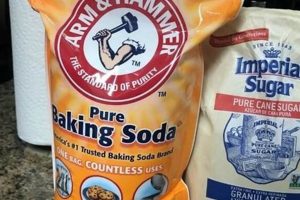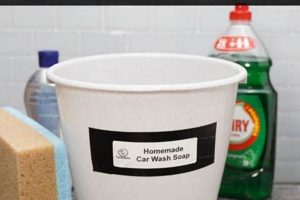A preparation created at home with the intention of removing surface contaminants from produce. For instance, a solution of diluted vinegar or baking soda in water is commonly employed for this purpose, followed by thorough rinsing. The primary aim is to eliminate dirt, pesticide residues, and other unwanted substances from the exterior of fruits and vegetables prior to consumption.
Employing such a method offers several advantages, encompassing potential cost savings compared to commercially available alternatives and greater control over the ingredients used, which can be particularly appealing to individuals seeking to minimize exposure to synthetic chemicals. Historically, the practice of cleansing fresh produce has been a standard food safety measure, with homemade solutions providing an accessible and customizable option.
The subsequent sections will delve into specific formulations, application techniques, and the scientific rationale behind the effectiveness of various components used in these homemade washing solutions. It will also address any potential limitations or considerations associated with their use, providing a balanced perspective on their role in promoting food safety.
Tips
Effective methods for cleaning produce at home hinge on appropriate techniques and understanding of solution properties. These guidelines ensure optimal removal of surface contaminants while preserving food quality.
Tip 1: Employ a vinegar solution. A mixture of one part white vinegar to three parts water provides an effective yet gentle cleansing action. Immerse produce for several minutes, then rinse thoroughly under running water.
Tip 2: Utilize baking soda. A tablespoon of baking soda per several cups of water creates an alkaline environment that aids in dislodging dirt and residue. Agitate the produce within the solution before rinsing.
Tip 3: Maintain solution hygiene. Prepare fresh batches of washing solution for each use to prevent the accumulation of bacteria or contaminants within the wash itself.
Tip 4: Scrub produce surfaces. For items with thicker skins, such as potatoes or apples, gently scrub with a soft brush while under running water or submerged in the chosen solution.
Tip 5: Rinse thoroughly. Regardless of the solution used, a comprehensive rinsing process is critical to remove any remaining residue from the washing agent and dislodged contaminants.
Tip 6: Consider produce type. Delicate items, like berries, benefit from a shorter soaking time to prevent waterlogging and damage. Harder produce can withstand longer immersion.
These practices contribute to minimizing potential exposure to unwanted substances on fruits and vegetables. Consistent application enhances the safety and quality of produce intended for consumption.
The following section will discuss the scientific evidence supporting the efficacy of different washing agents and techniques, offering a more detailed understanding of the processes involved.
1. Ingredients
The selection of components directly determines the efficacy and safety of a homemade produce cleanser. The type of substance employed, its concentration, and its potential interaction with the produces surface are all critical factors. For instance, white vinegar, a common ingredient, contains acetic acid, which exhibits antimicrobial properties effective against certain bacteria and residues. However, an excessive concentration of acetic acid can negatively impact the texture and flavor of the produce, underscoring the need for careful dilution.
Baking soda (sodium bicarbonate) represents another prevalent ingredient, acting as a mild abrasive and alkaline agent. Its efficacy lies in dislodging dirt and removing surface contaminants. A practical example is the utilization of baking soda solution to cleanse leafy greens, where it aids in removing soil and potential pesticide residues lodged in the crevices. Conversely, improperly diluted baking soda can leave a powdery residue, requiring thorough rinsing. Therefore, a precise understanding of ingredient properties and appropriate application methods is paramount.
The careful selection and preparation of components ensure that the homemade cleanser is both effective and safe for consumption. A balanced understanding of ingredient properties, their concentrations, and their interaction with different types of produce is crucial for successful implementation. The subsequent exploration of other factors, such as immersion time and rinsing methods, will further elucidate the comprehensive nature of proper produce cleansing practices.
2. Concentration
The proportion of active cleaning agents within a homemade produce wash is a critical determinant of its effectiveness and potential adverse effects. Striking the correct balance ensures adequate removal of contaminants without compromising produce quality or posing health risks.
- Efficacy Threshold
A minimum concentration of cleaning agent is necessary to disrupt the adhesion of dirt, pesticides, and microorganisms on the surface of fruits and vegetables. Below this threshold, the wash will be ineffective, leaving contaminants largely undisturbed. For example, a vinegar solution weaker than 3% acetic acid may fail to adequately sanitize leafy greens. Conversely, exceeding this threshold without careful consideration can lead to produce damage.
- Produce Sensitivity
Different types of produce exhibit varying sensitivities to cleaning agents. Delicate items, such as berries and leafy greens, are more susceptible to damage from high concentrations. Using a concentrated solution of baking soda on berries can cause them to become mushy or discolored. Conversely, thicker-skinned items like apples and potatoes can tolerate slightly higher concentrations without significant adverse effects. Therefore, concentration must be adjusted based on the specific produce being washed.
- Residue Concerns
Excessive concentrations of cleaning agents can leave behind undesirable residues on the surface of the produce. Even after rinsing, trace amounts may remain, potentially affecting the taste or posing a health risk. A high concentration of citric acid, for instance, can impart a sour taste to washed produce. Thorough rinsing is crucial to mitigate this risk, but starting with an appropriate concentration minimizes the potential for residual contamination.
- Safety Considerations
Certain cleaning agents, when used in overly concentrated solutions, can pose health hazards. Inhaling fumes from concentrated vinegar solutions can irritate the respiratory tract, and accidental ingestion of highly concentrated solutions of baking soda can cause digestive upset. Dilution to appropriate concentrations minimizes these risks, ensuring the safety
of both the person preparing the wash and the person consuming the washed produce. Always exercise caution and adhere to recommended dilutions.
In conclusion, proper concentration is paramount for effective and safe homemade produce washing. Consideration of efficacy thresholds, produce sensitivity, residue concerns, and safety aspects is essential for achieving optimal results and mitigating potential risks. Adjusting concentrations based on produce type and strictly adhering to recommended dilutions are crucial for maintaining both the quality and safety of the cleansed produce.
3. Immersion Time
Immersion time, the duration for which produce remains submerged in a cleansing solution, directly influences the efficacy of homemade washing methods. A cause-and-effect relationship exists between immersion time and the level of contaminant removal. Insufficient immersion fails to adequately dislodge dirt, pesticide residues, and microbial populations. Conversely, excessive immersion can lead to undesirable effects such as waterlogging, nutrient leaching, and textural degradation. For instance, delicate berries submerged for extended periods in a water-based solution become waterlogged, resulting in a diminished shelf life and altered palatability. Therefore, immersion time constitutes a critical control parameter within the process.
The optimal immersion time varies depending on several factors, including the type of produce, the nature of the cleansing solution, and the degree of contamination. Leafy greens, often harboring soil and pesticides within their intricate folds, generally require a shorter immersion time to prevent excessive water absorption. Root vegetables, with their robust exteriors, can withstand longer immersion periods, allowing for enhanced removal of adhered soil particles. A practical application of this understanding involves adjusting the immersion time based on visual inspection of the produce; heavily soiled items necessitate a slightly longer soak than those with minimal visible contamination. Furthermore, the concentration of the cleansing agent influences the necessary immersion time. Highly diluted solutions often require longer contact times to achieve comparable contaminant removal to more concentrated solutions with shorter immersion durations.
In summary, the duration of immersion is a fundamental element in homemade produce washing protocols. Striking a balance between effective contaminant removal and the preservation of produce quality requires careful consideration of produce type, solution composition, and contamination levels. Precise control over immersion time, guided by visual assessment and a fundamental understanding of the underlying principles, is essential for maximizing the benefits of homemade washing while minimizing potential adverse effects. Further research into specific immersion time recommendations for various produce and cleansing solution combinations could enhance the practical application of this knowledge.
4. Rinsing Method
The rinsing method forms an indispensable stage in homemade produce washing. Its execution directly influences the effectiveness of contaminant removal following the application of a cleansing solution. Inadequate rinsing negates the benefits of the wash solution, leaving dislodged dirt, pesticide residues, and microorganisms on the produce surface. Conversely, a properly executed rinsing method ensures the removal of these contaminants, promoting food safety. For instance, employing a gentle stream of water on leafy greens after soaking in a vinegar solution eliminates residual vinegar and dislodged debris, rendering them suitable for consumption. This critical step is often overlooked, yet it is integral to the overall efficacy of the washing procedure.
The selection of an appropriate rinsing method hinges upon the type of produce and the initial cleansing solution. Delicate fruits and vegetables, such as berries or spinach, benefit from a gentle shower or immersion in clean water, minimizing physical damage. Robust produce, like apples or potatoes, can withstand rinsing under a stronger water pressure or scrubbing with a soft brush. For example, rinsing apples under running water while gently scrubbing with a brush effectively removes wax coatings and any remaining contaminants. The rinsing method should also be adapted to the cleansing agent used. Produce washed with baking soda solution necessitates thorough rinsing to eliminate any alkaline residue that could affect taste or texture. Proper technique prevents the re-deposition of removed contaminants back onto the produce.
In summary, the rinsing method is not merely a supplementary step but a critical component of homemade produce washing. Its proper execution determines the success of the overall process in reducing contaminants and enhancing food safety. Adapting the rinsing technique to the type of produce and the cleansing solution used ensures optimal results, preventing the re-deposition of contaminants and preserving the quality of the produce. A comprehensive understanding of rinsing methods is, therefore, essential for individuals practicing homemade produce washing techniques.
5. Produce Type
The selection of appropriate homemade cleansing methods is intrinsically linked to the specific characteristics of the produce being washed. The surface texture, susceptibility to damage, and potential for absorbing cleaning agents necessitate tailored approaches to ensure effective contaminant removal without compromising quality. Different categories of fruits and vegetables require distinct handling protocols to maximize the benefits of at-home washing practices.
- Leafy Greens
Leafy greens, such as spinach and lettuce, possess a large surface area and intricate folds, creating numerous crevices where dirt, pesticides, and other contaminants can accumulate. These items are also delicate and prone to bruising, necessitating gentle washing techniques. Immersion in a diluted vinegar solution followed by thorough rinsing is a common practice. The potential for water absorption necessitates limiting immersion time to prevent wilting and loss of nutrients. Improper washing can result in residual contaminants or damaged leaves, rendering the produce less palatable or safe.
- Berries
Berries, including strawberries, raspberries, and blueberries, exhibit a high surface area-to-volume ratio and delicate skin, making them particularly susceptible to water absorption and damage. A brief soak in cool water or a very dilute vinegar solution, followed by gentle rinsing, is recommended. Vigorous washing can damage the berries, leading to spoilage. The presence of stems and caps can trap contaminants, requiring careful attention during the rinsing process. Improper handling can lead to mushy, moldy berries or ineffective contaminant removal.
- Root Vegetables
Root vegetables, such as carrots, potatoes, and beets, possess a robust exterior and are typically covered in soil. A more rigorous washing approach, involving scrubbing with a vegetable brush and rinsing under running water, is often necessary. Diluted vinegar or baking soda solutions can aid in loosening soil and removing pesticide residues. The rou
gh surface may harbor contaminants, requiring thorough cleaning to ensure safety. Inadequate washing can result in gritty or contaminated produce. - Fruits with Smooth Skin
Fruits with smooth skin, such as apples, pears, and peaches, generally require a less intensive washing method. Rinsing under running water, possibly with a gentle scrubbing action, is typically sufficient to remove surface contaminants. A diluted vinegar solution can aid in removing wax coatings or pesticide residues. The presence of natural waxes may limit the adhesion of contaminants, but thorough washing is still advisable. Inadequate washing can leave behind residues or coatings that affect taste or appearance.
These diverse requirements underscore the importance of tailoring homemade cleansing methods to the specific characteristics of each produce type. A one-size-fits-all approach can lead to ineffective contaminant removal or damage to the produce. By understanding the unique properties of different fruits and vegetables, individuals can optimize their washing practices to enhance food safety and preserve the quality of their produce.
6. Solution Freshness
The efficacy of homemade produce cleansing solutions is directly contingent upon their freshness. A freshly prepared solution possesses optimal cleaning capabilities, effectively removing contaminants such as dirt, pesticides, and microbial organisms. In contrast, a solution left standing over time degrades, losing its potency and potentially becoming a breeding ground for bacteria, thereby negating its intended purpose. For instance, a baking soda solution prepared days in advance may lose its alkalinity, diminishing its ability to dislodge surface residues. The inherent instability of certain components commonly used in these washes necessitates preparation immediately before use to ensure maximum effectiveness.
The practice of creating a new batch of washing solution for each use minimizes the risk of cross-contamination and preserves the integrity of the cleaning agents. This is particularly critical when utilizing organic ingredients or when avoiding preservatives that would otherwise extend shelf life but potentially introduce unwanted chemicals. Consider a scenario where a vinegar solution is reused multiple times; over time, particulate matter from the produce accumulates within the solution, turning it from a cleansing agent into a contaminated bath. Furthermore, the acetic acid concentration diminishes with each use, further reducing its effectiveness. The cumulative effect renders the solution less effective and potentially harmful, emphasizing the need for disposal after a single application.
The principle of solution freshness is paramount to the success of the home produce washing process. Prioritizing the preparation of a new solution each time produce is washed mitigates the risk of reduced efficacy and bacterial contamination. Understanding the ephemeral nature of these homemade washes ensures that efforts to cleanse produce result in a genuinely safer and cleaner final product. Diligence in this aspect significantly contributes to the overall effectiveness of homemade produce washing, reinforcing its value in promoting food safety and health.
7. Storage Effects
The storage conditions employed after produce is subjected to homemade washing practices exert a significant influence on its shelf life, nutritional content, and overall safety. Appropriate storage methods are essential to mitigate potential degradation and prevent the proliferation of spoilage organisms. The following outlines key considerations regarding the impact of storage on washed produce.
- Moisture Control
Washing produce introduces moisture, which, if not properly managed during storage, can accelerate spoilage. Excessive moisture promotes the growth of mold and bacteria, reducing shelf life. For instance, storing washed leafy greens in an airtight container without adequate ventilation traps moisture, leading to rapid deterioration. Conversely, allowing washed produce to air dry or utilizing containers with ventilation holes minimizes moisture accumulation, extending its usability.
- Temperature Management
Temperature plays a critical role in regulating the rate of enzymatic activity and microbial growth in washed produce. Refrigeration slows down these processes, preserving freshness and preventing spoilage. Storing washed berries at room temperature significantly reduces their shelf life compared to refrigerating them promptly after washing. Maintaining appropriate temperature control is, therefore, essential for maximizing the benefits of the washing process.
- Ethylene Sensitivity
Ethylene, a natural plant hormone, influences the ripening and senescence of certain fruits and vegetables. Storing ethylene-sensitive produce, such as broccoli and spinach, near ethylene-producing fruits, like apples and bananas, can accelerate their spoilage even after washing. Separating ethylene-sensitive produce from ethylene sources minimizes this effect, preserving its quality for a longer duration. Proper storage location becomes a crucial consideration post-washing.
- Contamination Prevention
Storage conditions must prevent recontamination of washed produce. Placing washed items in previously used containers without proper sanitation can reintroduce harmful microorganisms. Utilizing clean, sanitized containers and avoiding contact with potentially contaminated surfaces minimizes the risk of recontamination. Proper hygiene practices during storage are thus paramount to maintaining the benefits achieved through washing.
In conclusion, the storage environment profoundly impacts the quality and safety of produce that has undergone homemade washing procedures. Factors such as moisture control, temperature management, ethylene sensitivity, and contamination prevention collectively determine the success of preserving washed produce. A comprehensive understanding of these storage effects ensures that the efforts invested in washing translate into tangible benefits, extending shelf life, preserving nutritional value, and safeguarding against potential health risks.
Frequently Asked Questions
This section addresses common inquiries regarding the practice of at-home produce cleansing, providing succinct and evidence-based responses.
Question 1: Is water alone sufficient for cleaning fruits and vegetables?
While water can remove loose dirt and debris, it is generally insufficient for eliminating pesticide residues or microbial contaminants effectively. Additional cleaning agents are often necessary to achieve optimal results.
Question 2: What are the primary benefits of employing homemade washing solutions?
Homemade solutions offer cost savings compared to commercial washes, and allow for greater control over ingredients, reducing exposure to synthetic chemicals. The efficacy, however, depends on the correct preparation and application.
Question 3: Are there specific types of produce for which homemade washes are unsuitable?
Delicate items, such as berries, require extra care to avoid damage. Immersion time and solution concentration should be carefully monitored to prevent waterlogging or adverse effects on texture and flavo
r.
Question 4: How frequently should homemade washing solutions be prepared?
Solutions should be prepared fresh for each use to prevent the accumulation of bacteria and maintain optimal effectiveness. Reusing solutions can introduce contaminants and reduce their cleansing potency.
Question 5: Can homemade washes eliminate all pesticide residues?
While they can significantly reduce surface residues, complete elimination is not guaranteed. The efficacy depends on the specific pesticide, the washing agent, and the washing method employed. Produce labeled as “organic” still benefits from washing.
Question 6: What are the potential risks associated with improper homemade washing techniques?
Inadequate rinsing can leave behind residues from the washing agent, while overly concentrated solutions can damage produce or pose health risks. Adhering to recommended dilutions and rinsing procedures is crucial.
Proper homemade produce cleansing involves a multi-faceted approach, balancing solution effectiveness with produce preservation and safety considerations.
The subsequent section will summarize key takeaways from this article, providing actionable insights for implementing effective at-home produce cleansing practices.
DIY Fruit and Vegetable Wash
This exploration of “diy fruit and vegetable wash” has illuminated the key considerations for creating and utilizing these homemade solutions. Effective implementation requires a careful balance of ingredient selection, concentration control, immersion time management, and appropriate rinsing techniques, all tailored to the specific type of produce being cleansed. Emphasizing solution freshness and proper storage further contributes to mitigating potential risks and maximizing benefits. The practice, when executed with diligence, offers a viable method for reducing surface contaminants on fruits and vegetables.
The information presented underscores the importance of informed decision-making in the realm of food safety. While “diy fruit and vegetable wash” provides a pathway to greater control over the cleansing process, it is imperative to adhere to established guidelines and prioritize safety above all else. Ongoing research and awareness regarding effective techniques remain essential for optimizing the benefits and minimizing potential drawbacks of this practice.







